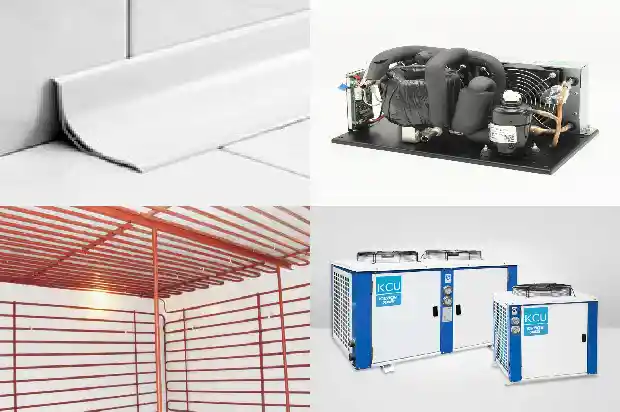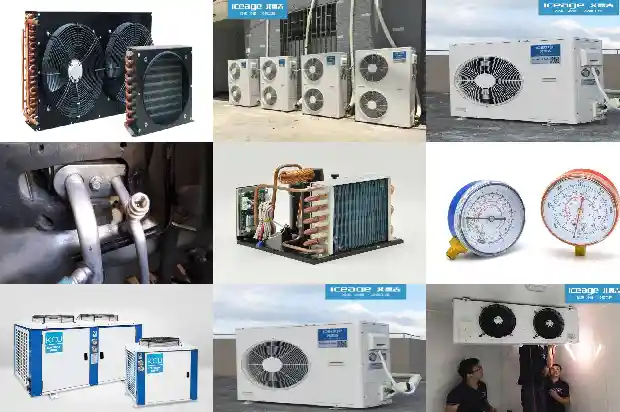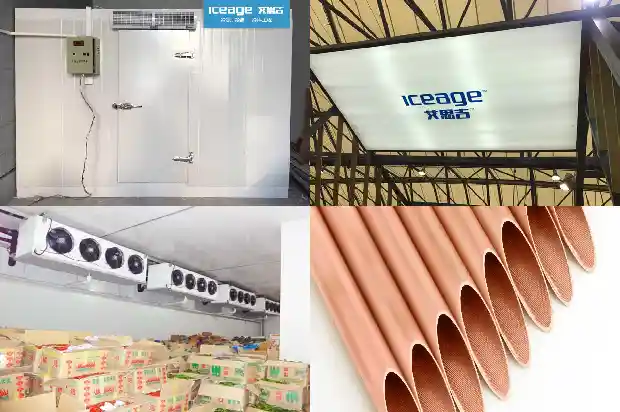Analysis of Seven Reasons for Ice Formation in Computer Room Air Conditioners
2025-02-14
In summer, the indoor unit evaporator of small split - type air conditioners often freezes. Why does this happen and how can it be resolved? The details are as follows:
First Reason: Insufficient Refrigerant
Due to reasons such as installation or long - term use, split - type air conditioners may experience refrigerant leakage or seepage.
Due to reasons such as installation or long - term use, split - type air conditioners may experience refrigerant leakage or seepage.

Second Reason: Low Compressor Efficiency
If the compressor has been in use for a long time, its compression efficiency may decrease, or the gas - distribution system of the compressor may be damaged, resulting in too low pressure and causing the evaporator to freeze. The frozen area is also in the front part of the evaporator. For the former case, adding some refrigerant may resolve the fault. If the fault persists, the compressor needs to be replaced.
If the compressor has been in use for a long time, its compression efficiency may decrease, or the gas - distribution system of the compressor may be damaged, resulting in too low pressure and causing the evaporator to freeze. The frozen area is also in the front part of the evaporator. For the former case, adding some refrigerant may resolve the fault. If the fault persists, the compressor needs to be replaced.
Third Reason: Excessive Refrigerant in the Computer Room Air Conditioner
Some air conditioners have their refrigerant re - injected due to relocation, leakage, etc. If maintenance personnel operate improperly and add too much refrigerant, the excess refrigerant will flow to the rear part of the evaporator and evaporate there, causing ice formation. This kind of ice usually forms in the rear part of the evaporator and around the compressor's suction pipe. By releasing the excess refrigerant, the fault can be eliminated.
Some air conditioners have their refrigerant re - injected due to relocation, leakage, etc. If maintenance personnel operate improperly and add too much refrigerant, the excess refrigerant will flow to the rear part of the evaporator and evaporate there, causing ice formation. This kind of ice usually forms in the rear part of the evaporator and around the compressor's suction pipe. By releasing the excess refrigerant, the fault can be eliminated.
Fourth Reason: Dirty Heat Exchanger
After an air conditioner has been used for a period of time, dust in the air or microorganisms generated by the evaporator will accumulate on the evaporator, blocking air circulation, reducing heat exchange, and causing the evaporator temperature to be too low and freeze. The frozen area is in the rear part of the evaporator. After the ice melts, rinse the evaporator with water and brush it along the fins with a soft brush. Be careful not to wet the electrical parts. After cleaning thoroughly, the fault will be resolved.
After an air conditioner has been used for a period of time, dust in the air or microorganisms generated by the evaporator will accumulate on the evaporator, blocking air circulation, reducing heat exchange, and causing the evaporator temperature to be too low and freeze. The frozen area is in the rear part of the evaporator. After the ice melts, rinse the evaporator with water and brush it along the fins with a soft brush. Be careful not to wet the electrical parts. After cleaning thoroughly, the fault will be resolved.
Fifth Reason: Faulty Temperature Probe or Improper Installation of Temperature Probe
For mechanical thermostats, the gas pressure in the temperature - sensing bulb changes with temperature, driving the contacts of the thermostat to act. Due to reasons such as contact adhesion and insufficient spring elasticity, the contacts remain closed, causing the air conditioner to run continuously and resulting in ice formation. Replacing the thermostat can resolve the fault.
There are also special cases where the thermostat is not damaged, but the air conditioner has a short shutdown time or does not stop. The temperature - sensing bulb is suspended in the middle of the evaporator by a U - shaped plastic frame, about 2mm away from the fins. Presumably, the manufacturer designed it this way to make the temperature - sensing bulb of the thermostat have a temperature - delay effect and prevent the air conditioner from starting frequently within a short time (within 3 minutes). In midsummer, the indoor temperature is high, and due to the limitations of the air conditioner's refrigeration capacity, the thermostat can hardly reach the temperature - control cut - off point.
For mechanical thermostats, the gas pressure in the temperature - sensing bulb changes with temperature, driving the contacts of the thermostat to act. Due to reasons such as contact adhesion and insufficient spring elasticity, the contacts remain closed, causing the air conditioner to run continuously and resulting in ice formation. Replacing the thermostat can resolve the fault.
There are also special cases where the thermostat is not damaged, but the air conditioner has a short shutdown time or does not stop. The temperature - sensing bulb is suspended in the middle of the evaporator by a U - shaped plastic frame, about 2mm away from the fins. Presumably, the manufacturer designed it this way to make the temperature - sensing bulb of the thermostat have a temperature - delay effect and prevent the air conditioner from starting frequently within a short time (within 3 minutes). In midsummer, the indoor temperature is high, and due to the limitations of the air conditioner's refrigeration capacity, the thermostat can hardly reach the temperature - control cut - off point.

Sixth Reason: Small Air Volume in the Indoor Unit of the Computer Room Air Conditioner
After the air conditioner has been used for a period of time, some fan blades may stick with a lot of dirt, affecting the air supply and causing the evaporator to freeze. Removing the dirt can resolve the fault.
Some fans may also have their rotational speed slowed down due to mechanical or electrical faults, resulting in a small air volume and causing the evaporator to freeze. Mechanical reasons are mostly due to wear of bearings and bushings, increased resistance, and a slowed - down rotational speed. Electrical faults are mostly due to capacitor charge - discharge failure or inter - turn short - circuit of the fan, resulting in a slow rotational speed, and even the fan winding may burn out and the motor stops.
After the air conditioner has been used for a period of time, some fan blades may stick with a lot of dirt, affecting the air supply and causing the evaporator to freeze. Removing the dirt can resolve the fault.
Some fans may also have their rotational speed slowed down due to mechanical or electrical faults, resulting in a small air volume and causing the evaporator to freeze. Mechanical reasons are mostly due to wear of bearings and bushings, increased resistance, and a slowed - down rotational speed. Electrical faults are mostly due to capacitor charge - discharge failure or inter - turn short - circuit of the fan, resulting in a slow rotational speed, and even the fan winding may burn out and the motor stops.

Seventh Reason: Too Low Temperature Setting
Some users set the temperature of the air conditioner too low. The air conditioner's cooling capacity cannot keep up, and the room temperature cannot drop to the set temperature, so the air conditioner runs for a long time, or the shutdown time is very short, which can also cause the evaporator to freeze. In some cases, if the room temperature drops very low, the evaporator temperature will be too low and freeze. This kind of ice usually starts to form from the lower part of the evaporator. Just setting the temperature higher can resolve the fault.
Some users set the temperature of the air conditioner too low. The air conditioner's cooling capacity cannot keep up, and the room temperature cannot drop to the set temperature, so the air conditioner runs for a long time, or the shutdown time is very short, which can also cause the evaporator to freeze. In some cases, if the room temperature drops very low, the evaporator temperature will be too low and freeze. This kind of ice usually starts to form from the lower part of the evaporator. Just setting the temperature higher can resolve the fault.
Related Articles
- Analysis and Troubleshooting of Common Faults in Air - source Heat Pumps
- Analysis of 6 Components in Air - cooled Multi - split Systems
- Analysis of Advantages, Disadvantages and 34 Common Components of Multi - split Air Conditioners
- Common Causes and Analysis of High and Low Pressure Alarms
- Common Causes and Analysis of Compressor Thermal Protection
- Analysis of Common Faults in Compressor Overcurrent and Burnout
- Analysis of Causes for Safety Valve Leakage
- Analysis of Refrigeration Compressor Motor Faults
- Fault Analysis of Working Principle of Screw Chiller Unit
- Analysis and Treatment of Common Low-Pressure Faults in Chillers
- Analysis and Treatment of Common Low Pressure Faults in Chillers
- Water Cooled Unit Principle of Operation and Parameter Failure Analysis
- What Are the Common Reasons for Difficulties in Cooling a Cold Storage?
- Reasons for Frost Formation in Cold Storage and Defrosting Methods
- What Are the Reasons for Insufficient Air Output of Screw Air Compressors?
- Reasons for Pump Body Failures in Cold Storage Compressors
- What are the reasons for the inactivity of the automotive air conditioning compressor? What are the common faults?
- What are the reasons for the frequent start-up and tripping of the refrigerated air dryer in the cold storage?
